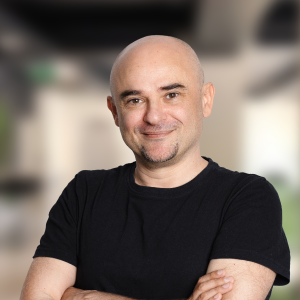Fundaments
We live in times when the world is developing very fast. Newly emerging ideas and products are revolutionary to the market and to the whole world around us.
Many entrepreneurs try to take part in this global digital revolution. They focus on creating innovation for the user, launching a product or service that will change the world. Nowadays many innovative products have software components inside or are just software-based.
However, it should be remembered that to create a great product you need an idea, an innovator as a person, but also a technical team of software developers and other specialists with strong skills who will build it, implement and ensure effective operations. Gathering the right team and skills for quality process of software development is the basis for your future success of your business. Effective development teams are the foundation of successful companies and their projects. A good agile software development team often creates new ideas, increases creativity, and finds innovative solutions for problem-solving.
A well-functioning software development team structure often has an impact on the environment in which it operates. Additionally, creativity, strong skills, productivity, or ambition are contagious and spread to other teams operating in the company.
Development team
Unfortunately, creating great software development teams is a huge challenge. To do this, you need to connect the right people with the right goals in the right environment of one project. Thinking about it, you can say that there are some patterns in creating the effective software development team and sucessful project management.
Software development team roles
Often, one of the goals for the software development team structure is to create a quality digital product and insure quality assurance of projects.
To create an innovative digital product you need to have in the team different team members – software development experts with various talents, skills, roles and responsibilities.
Considering this problem in terms of organization we could distinguish roles such as Product Owner, Architect, Tech Lead, Project Manager, UX and/or UI designer, Software Developer, Tester, DevOps, and others, where:
- Product Owner collects all reported client’s needs and business goals, and based on business needs, creates full descriptions of requirements for projects and software development teams;
- Architect is an expert in the field of software, making high-level decisions regarding the design and setting technical standards, selecting programming languages, tools, and platforms used ;
- Technical Leader looks at the product broadly, understands the specifics of a given domain or technology in which he works. Tech lead solves development problems which are not visible on the surface, e.g. related to security, legal regulations, quality assurance or application scaling during the agile software development process;
- Project Manager is responsible for planning, executing. Closing the project is also one of the responsibilities of project managers;
- UX Designer usually participates in the process of acquiring customer requirements, analyzes the competition and available tools. After collecting requirements from the client, specialist creates users’ usage scenarios;
- UI Designer “stylizes” the entire interface and the designed process, delivering graphics and other visible components;
- Software Developer is a person who analyzes requirements for the software, designs, and makes sure that ordered functionalities are implemented;
- Software Tester checks and often also maintains the quality of the product;
- DevOps prepares environments (development and/or production) for the software development, tests and implementation.
Depending on the complexity of the project there may be more or less of these roles required. Sometimes you could also observe cases of combining more than one role by the same person.
Technological aspects
However, if we focus on creating a software digital product from a technology standpoint, we will be able to distinguish experts from different perspectives. For example, we could talk about front end developers, back end, or mobile specialists.
- Front End Developer is usually responsible for what the users of a given application or website see. It is therefore responsible for the implementation of various types of elements visible by the user of e.g. animations to the project;
- Back End Developer is normally responsible for providing server-side solutions – part of the software projects where application or website receives necessary data – invisible for the user. He is often taking care of the maximum optimization of the code to improve the functioning of the project and/or ensure security for the project;
- Mobile Developer is often a specialist responsible for programming the mobile application. Mobile Developer updates application, adds functions and possibilities;
Technological split can be of course deepened to include other specializations, or particular technologies, programming languages on environments.
Non-technological aspects
A good software programming team however is not only about selecting people with appropriate technical competencies or performing appropriate roles or tasks.
A good software development team has common goals to achieve, works in a common environment, and develops a common work culture. It also consists of the right members who care about proper communication and soft skills, a clear division of development team roles and responsibilities. Good team members can also be independent and make their own decisions.
Goals
Establishing clear and understandable goals for the agile software development team is crucial. Before starting work, make sure that all team members know what direction they are going and why they are doing it. Without this, it will be very easy to lose the path we are following and become unmotivated.
Parallel to the pursuit of common goals, effective software development team members support each other and develop a sense of shared responsibility for the project. Everyone feels involved, celebrates successes together, and thinks about how to avoid failures. Good teams usually avoid a heavy top-down software development team structure in which only senior management cares about achieving goals. They believe that each team member has a vital role to play in achieving project team success.
Team culture
A strong team culture characterizes great teams. A good team often develops its own specific way of working, rituals, communication channels, sometimes even nomenclature of processes, terminology, or nicknames for the team. This approach brings people together and makes them more effective. It makes work more enjoyable, increases satisfaction and morale in the team.
Excellent team culture cannot be imposed. Usually, it develops in the right environment while the team is functioning. Pay attention to how people cooperate with each other, combining the appropriate personalities and talents. A lot also depends on the team leaders and their development both in terms of technology and organizational culture.
For example, a project team spending time together outside of work can be good indications of a shared culture. It is not something that can be forced, but you can support these processes. Examples include joint activities such as meals, going out, team games, or events for improved communication.
Communication
Good teams communicate in the right way. The information exchange is natural and has no barriers. At the same time, we take care not to flood everyone with the smallest details of one project, we do not waste time on unnecessary meetings. We are looking for solutions that help us focus the discussion on the goal or problem to be solved. The members of a well-connected project team know perfectly well in which direction they are going, communicate freely, sharing their ideas, and informing about risks. They can talk openly about their feelings, about the problems they encounter, and look for solutions together.
Good communication can be supported by using the right communication tools or channels, explaining why particular goals should be achieved and tasks should be done. Open, regular thematic meetings can be held to support the exchange of thoughts, observations, or comments. The use of modern technologies can additionally support internal team communication and communication with client.
Areas of responsibility
In parallel with their shared goals, individual team members have individual roles to play and personal areas of responsibility. People rely on each other. Trust each team member to play their part in moving the project forward, and together they keep their development promises. They know who is responsible for particular areas, in terms of design, technical or product decisions.
A clear division of responsibilities is the foundation of a good team. Members can trust that others will get the job done, while at the same time focusing on delivering the results of their personal work. Well-defined roles help every person to avoid misunderstandings or frustration in the team.
Independence
Technical teams that face too many internal obstacles have a hard time achieving their goals easily, not to mention success. In order for the agile software development team to thrive, it should have the right amount of freedom to carry out experiments to find its own way to the goal. They need a space where they can develop without being overwhelmed by the top-down control that usually hinders such processes.
Strong software development teams often act independently as decision-makers. Supporting the development of internal teams is important, it is worth organizing the environment in such a way that it does not have too many processes that could slow down or limit team activities.
Do not overdo it so that the decisions needed for the development process of both the project and the team can be made quickly.
Summary
It is important to regularly check how work is progressing in individual agile software develpment team. It can be done in a more or less formal way, but it is nevertheless worth talking, analyzing, and constantly adjusting the rules of functioning to the changing external conditions.
I hope that a handful of this information will allow you to prepare better for the success of creating good software development teams. At the same time, it will show that building the right team and facilitating its functioning is one of the best ways to create innovative products that change lives of its users.
Our company has been supported by EIT Urban Mobility, an initiative of the European Institute of Innovation and Technology (EIT), a body of the European Union. Learn more here: www.eiturbanmobility.eu
The support consisted in mentoring for the business plan development, as part of a programme of the Regional Innovation Scheme: https://www.eiturbanmobility.eu/ris/

If you need support with the software development for your project, we will help with frontend, backend, UI /UX and others. Check our services and tech block on the website menu.



